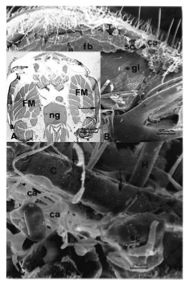
Remember our recent report concerning pesticides? I used a chemical reference database to go through the list and see if I could find any that were lipid-soluble. While many pesticides I looked at were not lipid-soluble, the four chemicals implicated in increasing honeybee vulnerability of Nosema infection in the study above are lipid-soluble. The clearest example is with the fungicide chlorothalonil due to the molecule’s relatively simple chemical structure. The aromatic ring makes the chemical lipid-soluble and the four chlorines make the molecule stable in the environment.

Not to offend any honeybees reading our blog, but honeybees have fat! Ya’ll wear it well though 😉

Aggregations of fatty tissues called fat bodies on the inner surfaces of their abdomens to be more exact. I was not able to find any good pictures of honeybee fat bodies online, but I did find a good picture of fat bodies in the stingless bee Scaptotrigona postica seen in the picture to the right.
An article on honeybee anatomy titled “Standard methods for Apis mellifera anatomy and dissection” published in the Journal of Apiculture Research says fat bodies are most prominent and abundant in larvae, young bees, non-foraging bees, winter brood honeybees, and queens (Carreck et al 2013).
Honeybees experience rapid reductions in fat tissue volume. Honeybee fat bodies are metabolized for energy during periods of food scarcity, during winter hibernation, and during development. Because developing bees, queens, and winter brood bees have more prominent fat bodies, and because these groups are often more vulnerable to extraneous factors effecting their health, it’s possible the metabolism of fat tissue and release of any fat-soluble chemicals could more likely harm these groups compared to others. Winter bees for instance don’t defecate for the entirety of their hibernation and may have reduced toxin-clearing system function. If colonies are already weakened by food scarcity, extreme cold, or pathogen infection, honeybee health could be further diminished by toxic chemicals, lowering immune system function and possibly increasing likelihood of pathogenic infection.
My focus next semester will be to find a way to isolate honeybee fat bodies and layout appropriate experiment methodology to test for the presence of pesticides and other potentially toxic synthetic compounds. I’m curious to see whether we find any of the four pesticides implicated in increasing chances of Nosema infection in previous research, and at what concentrations. It would also be interesting to test for common impurities and toxic byproducts of these and other chemicals, because sometimes an unstable chemical can degrade to a substantially more toxic chemical in the environment. Looking forward to an exciting new year working in the lab and learning much more about factors affecting honeybee health, how to prevent losses, and how to improve bee health.
This post was written by Todd Waters, an undergraduate intern in our lab.
References:
CARRECK, N L; ANDREE, M; BRENT, C S; COX-FOSTER, D; DADE, H A; ELLIS, J D; HATJINA, F; VANENGELSDORP, D (2013) Standard methods for Apis mellifera anatomy and dissection. In V Dietemann; J D Ellis; P Neumann (Eds) The COLOSS BEEBOOK, Volume I: standard methods for Apis mellifera research. Journal of Apicultural Research 52(4): http://dx.doi.org/10.3896/IBRA.1.52.4.03
Cruz, Landim C., and Reginato R.D. (1999) Preliminar Report on the Presence of Tegumentar Glands in the Thorax of Meliponinae Bees (Hymenoptera, Apidae). Revista Brasileira de Biologia 59(1): 167-172. Web. 6 Jan 2014.
Pettis JS, Lichtenberg EM, Andree M, Stitzinger J, Rose R, et al. (2013) Crop Pollination Exposes Honey Bees to Pesticides Which Alters Their Susceptibility
to the Gut Pathogen Nosema ceranae. PLoSONE 8(7): e70182. doi:10.1371/journal.pone.0070182. Web. 2 Dec 2013.